
NINCO Honda NSX Arrives!
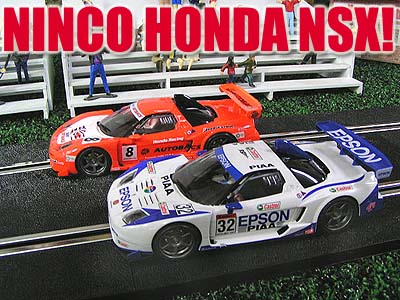 Most likely, the release of the Honda NSX is the most important of the NINCO
line-up this year. The popularity of these cars have been growing in our hobby
at a steady rate and for good reason too. The prototypes account for some really
great 1:1 racing action and it was only a matter of time before someone started
to create them in our hobby.
Most likely, the release of the Honda NSX is the most important of the NINCO
line-up this year. The popularity of these cars have been growing in our hobby
at a steady rate and for good reason too. The prototypes account for some really
great 1:1 racing action and it was only a matter of time before someone started
to create them in our hobby.
Granted, smaller companies have released some versions of these models, but I
have had my sites set on NINCO. They usually not only release a very good model,
but they continue a series of models for quite awhile which not all slot car
manufactures can claim. This is a good thing as once racers get addicted to a
certain model, they can count on more versions and liveries down the road.
Both of these models arrived safe and sound from MRC. Although I am no expert on this racing series, a quick educational trip through the internet told me that NINCO has done a great job in reproducing them in our scale. No, you won't see any micrometer measurements from me, but according to the photos of the 1:1 cars I have seen tells me enough to say that the efforts NINCO has put forth have succeeded.
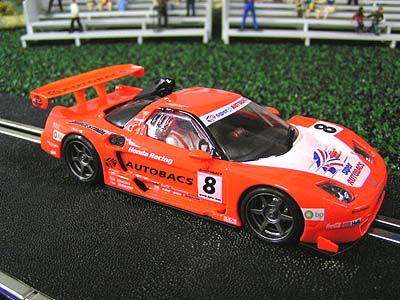
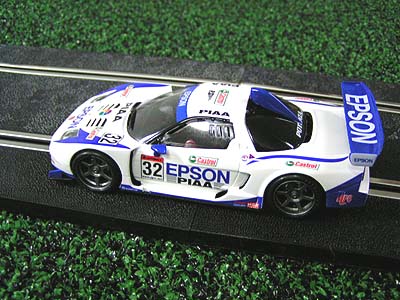
The fit and finish on these models were very well done. The Autobacs #8 model might be a little on the bright side though. The prototype photos though do show a very strong orange/red color and sometimes getting an exact match is difficult. Experts in this series will have a better idea and hopefully the photos show you all you need to make your decision. The white on the front of this model did have some slight bleed through as well, but it isn't that major. Covering this color is not the easiest task and NINCO did a fair job of it.
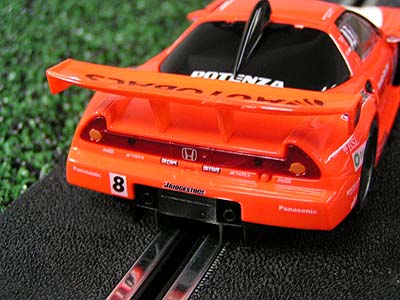
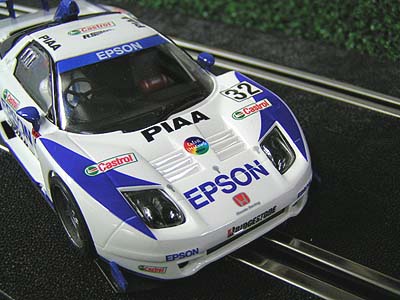
Tampo stampings and markings were very crisp and seemed accurately placed. Overall both these models seem to be excellent representations of the 1:1 car and should please most enthusiasts of the hobby and this series. I say this as I brought one of these models with me to the recent Midwest Slot Car Swap Meet and showed it to many Home Racing World members and friends. All of the comments I heard were positive and they felt NINCO had created a very nice looking model.
Standard NINCO design is present in the interior as well with a half tray type design utilized. For most enthusiasts, this has always been more than enough to satisfy their scale needs and once again I feel it holds true here. Having this type of design allows the modeler a little more room to work inside the model if they desire too. (like installing a light kit or adding magnets or lead) It also helps out by being lighter, and for some advanced enthusiasts, this is a major factor in their tuning procedures. (Weight out of the box was 84 Grams)
Wheels and tires are also very well done and represent the prototype nicely. The tires on this model are of a soft compound and I can be honest and say that silicone tires will not be used on our models here. These tires hook up very well on both NINCO track and other smoother tracks such as Artin and Carrera. The did need a little sanding to get them true, but it was minimal on both our samples. If want to use silicones, Indy Grips for the BMW #IG2011 will fit nicely.
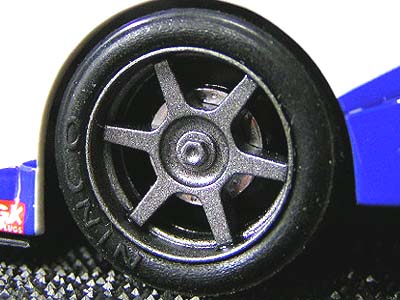
Looking under the model we see the biggest surprise of them all. NINCO has decided to go with an angle-winder motor configuration just like they did on the BMW. Personally, I liked their first effort at this, and I was glad to see it find its way here. The initial test of the gear mesh seemed very smooth and durable. The 20,00 rpm NC-5 Speeder motor is equipped with a 12 tooth pinion while the spur gear has 32. This gear combination seemed to match this model very well during testing and I plan on keeping it the way it comes out of the box.
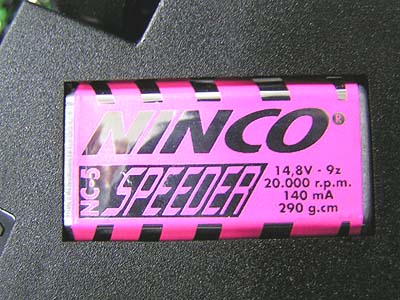
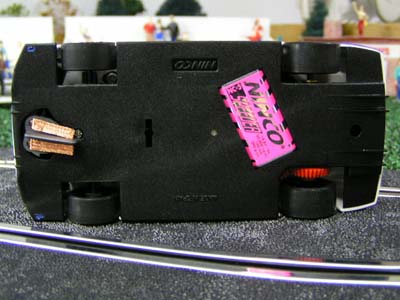
I have not been a big advocate of the stronger and faster motors finding their way into some of our models. I feel this way as most of the milder motors are more than enough for most enthusiasts, especially beginners. There are plenty of these newcomers, along with veterans that have a hard enough time controlling these models in the corners now, much less with even more power. This holds especially true when you are running with standard power supplies that feed too much voltage to them, yet starve these more powerful motors for amperage.
However, in this case...this motor seems to have found a perfect home. The acceleration and braking are very robust and this kind of power seems to fit this model better than I expected. The first few laps with model revealed this rather quickly and I soon found myself getting addicted to it. The body design of this model just allows a better balance for a stronger motor like this and helps a great deal in the overall control factor for my driving style.
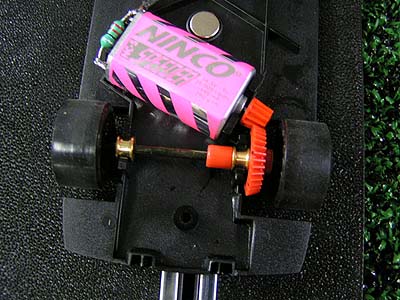
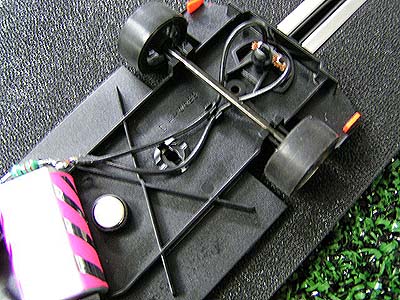
There are 2 screws that mount the body to the chassis and were easily removed. Inside we get a better view of the power-plant and wiring. We also see that the chassis has some added cross braces to it to help keep it true. The rear of the model shows how the angle-winder is set-up with a shimmed axle to help keep side to side to side free-play at a minimum along with keeping your gear mesh correct.
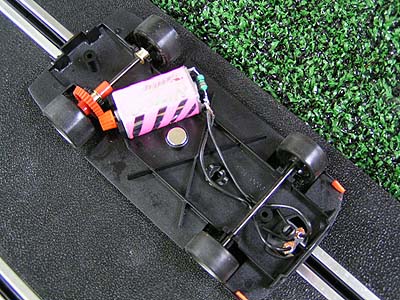
Up front we see the molded wire mounts that help keep the guide wires from rubbing the front axle and also helps to act as a self centering system. The front axle has plenty of vertical free-play, which if your racing on uneven track does come in handy. However, if your track surface is smooth, you might want to shim this axle to help minimize excess body roll. I set one of the models on a set-up block (you can use your track if you want as well, in fact that is better as you can tune it to a specific surface) to see how much shimming I needed. You can use anything to shim these axles, so there really is no wrong way. I used some scrap styrene for our model and simply glued them in place as shown.
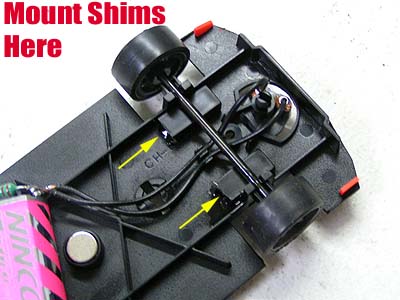
I have covered this process before with the NINCO Audi TT, so you can head over there and give that a read if you wish. However, I have used some of the photos here to show you a little better on the process.
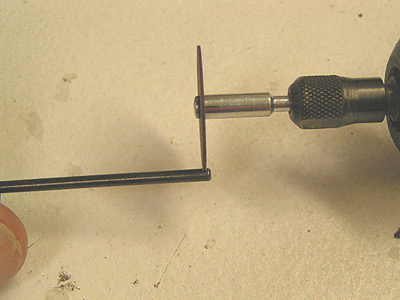
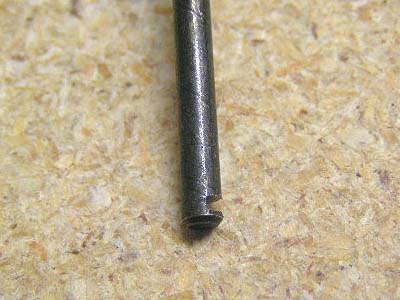
A good many of NINCO models also have excess side to side free-play in this solid front axle design. The best way I have found to fix this is to remove one front wheel and using a Dremel or similar moto-tool with a cut-off disc, trim the axle slightly and re-install the wheel. Start by taking off only the thickness of the disc, as this will most likely be just enough to clean things up. Once you cut away some of this excess, take some sandpaper and clean up the edges of the axle. This makes sure all the metal flashing is removed and the wheel will go back on clean and even. Once I get the distance that I want, add a very light drop of adhesive to the end of the axle and then mount the wheel.
Just in front of the motor we see the tried and true NINCO button magnet. I am going to go on record and say that this is more than enough magnet for this model to suit me. The pinning action it provided due to its distance from the rails really keeps this model planted firmly enough, and I don't plan on removing this magnet either like on some other models. This particular car just would not feel right power sliding around the layout.
Our tests here had this model lapping in the 4.3 second range out of the box. This was running at 12 volts only. Turning up the volts to 15 really made this model a handful on our medium sized layout. The good thing is that a milder NC-2 will snap right in place if you want to tweak this model for smaller layouts such as ours. The button magnet did a good job, but still allows some drifting action to warn you that you are pushing too hard. Even at my age, the reaction time is manageable. With the above modifications performed, our times dipped slightly in the 4.2 range. The time isn't really that much better, but the overall control felt better for me.
However, if you like your models with more magnetic down-force, you are also in luck. Since NINCO doesn't fill the inside of the body and chassis with needless detail, you have room to work. The best possible place for a magnet is right behind the motor. You can either tuck a bar magnet or button magnet back here with room to adjust front or back. This amount of room also gives you plenty of options to tune with lead and discard the magnet. So regardless on how you like your models, this chassis should be able to please most of you.
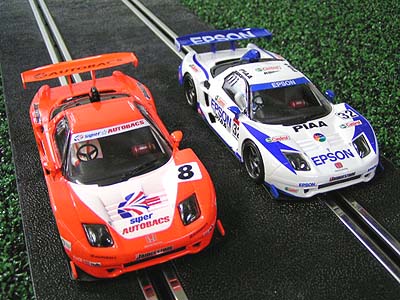 There are a few models that NINCO has released
over the years that quickly became fan favorites. It just seems that sometimes
they really sit down and create not only a nice looking model, but one that is a
lot of fun to operate as well. In my personal opinion, this model is one of
them. Matching it up with later releases in the future is going to create a very
even and fun racing event. Even if you are not a fan of this series in the 1:1
world, I think you owe it to yourself to give this release more attention. I
would advise anyone in this hobby to give these models a try, and add a pair of
them to their collection soon.
There are a few models that NINCO has released
over the years that quickly became fan favorites. It just seems that sometimes
they really sit down and create not only a nice looking model, but one that is a
lot of fun to operate as well. In my personal opinion, this model is one of
them. Matching it up with later releases in the future is going to create a very
even and fun racing event. Even if you are not a fan of this series in the 1:1
world, I think you owe it to yourself to give this release more attention. I
would advise anyone in this hobby to give these models a try, and add a pair of
them to their collection soon.
-Harry
As always feel free to contact me about this article or just the hobby in general at harry@homeracingworld.com, or better yet drop into our Message Forum and share your thoughts with other enthusiasts!
Thanks Go To MRC For Providing Us With This Model!
These models will be available before Thanksgiving, so check with your favorite dealer soon.